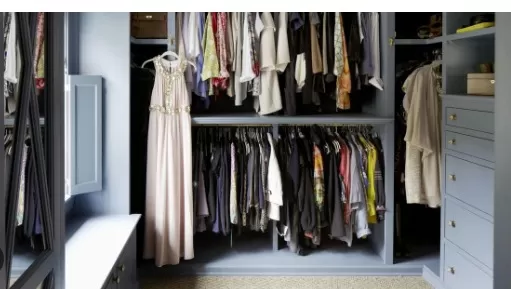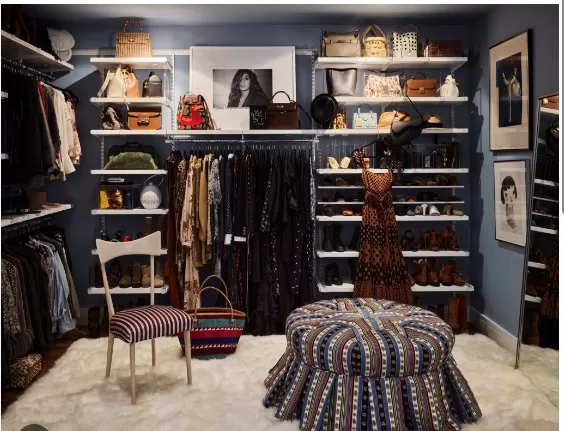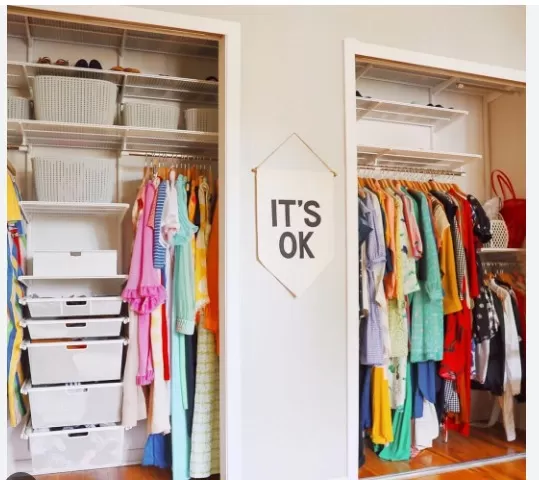Maximizing Closet Space: Avoid These Common Wasting Habits. The quality of a closet isn’t solely determined by its square footage; it’s about how effectively you utilize the space you have. Whether your storage area is small or large, there are always opportunities to reconfigure and optimize every inch.
By identifying and addressing poor storage habits, you can reclaim valuable space in your closet. Take a moment to review these helpful tips that will help you identify and eliminate any practices that are hindering your storage efficiency. With this newfound knowledge, you can embark on a transformative organizational overhaul, tailored to suit your needs and make the most of your closet space.
Maximizing Small Closet Space

Having a small closet doesn’t mean you have to sacrifice organization and functionality.
By making the most of every inch, you can transform your closet into a smart storage solution. Here are 12 ways you might be wasting space in your closet and suggestions for optimizing it:.
Neglecting vertical space: Utilize the vertical space in your closet by installing additional shelves or using hanging organizers that make use of the full height of the closet.
Not using the back of the door: Install hooks or an over-the-door organizer on the back of the closet door to hang bags, scarves, or belts.
Cluttered floor: Clear the floor of your closet by using hanging shoe organizers or shoe racks that can be attached to the door or hung from a closet rod.
Improper hanger use: Use slim hangers to maximize space and keep clothes from overlapping.
Consider cascading hangers for items like pants or skirts.
Underutilized shelf space: Make use of the shelf space in your closet by using storage bins or baskets to neatly store folded clothes, accessories, or seasonal items.
Lack of drawer dividers: Use drawer dividers to create compartments for smaller items like socks, underwear, or accessories, maximizing the storage capacity of your drawers.
Ignoring corners: Install corner shelves or hanging rods to utilize often overlooked corner spaces in your closet.
Overstuffing: Avoid cramming too many items into your closet.
Declutter regularly and donate or sell items you no longer need to create more space.
Inefficient use of hanging space: Utilize double-hang closet rods or install a closet rod extender to double the amount of hanging space in your closet.
Poor lighting: Improve visibility in your closet by adding lighting fixtures or using stick-on LED lights to make it easier to find and access your items.
Neglecting the top shelf: Use the top shelf of your closet to store less frequently used items in labeled bins or boxes.
Lack of organization: Implement a system that works for you, such as grouping clothes by type or color, using labeled bins, or investing in closet organization systems that offer adjustable shelves, drawers, and accessories.
Remember, every closet is unique, so adapt these suggestions to fit your specific needs and available space.
With a little creativity and smart planning, you can transform your small closet into an efficient and organized storage space.
Managing an Overflowing Shoe Collection
While shoes can be a source of joy and self-expression, an excessively large and unused shoe collection can take up valuable space in your closet.
Here are some steps to help you regain control and create more room:.
Assess your collection: Take a critical look at your shoes and evaluate each pair.
Identify those that are uncomfortable, out of fashion, heavily damaged, or no longer suitable for your current lifestyle.
Declutter: Set aside the shoes you no longer wear or need.
Consider donating them to a local charity, selling them online or at a garage sale, or giving them to friends or family members who might appreciate them.
Prioritize versatility: Keep shoes that are versatile and can be worn with multiple outfits.
This will help you streamline your collection and make it easier to mix and match.
Consider comfort: Pay attention to the comfort level of your shoes.
If you have pairs that are causing discomfort or pain, it may be time to let them go and make room for more comfortable options.
Quality over quantity: Focus on keeping shoes that are in good condition and have a reasonable lifespan ahead.
Investing in quality footwear will ensure longevity and reduce the need for constant replacements.
Maximize storage: Once you’ve decluttered your shoe collection, organize them in a way that maximizes your closet space.
Utilize shoe racks, hanging organizers, or clear plastic shoe boxes to keep them neatly stored and easily accessible.
Rotate seasonally: Consider storing seasonal shoes in a separate location during off-seasons.
This will free up space in your closet and allow you to focus on the shoes you need at any given time.
Regular maintenance: Take care of your shoes by cleaning, polishing, and repairing them as needed.
Proper maintenance can extend their lifespan and keep them looking their best.
Remember, maintaining an organized and manageable shoe collection not only frees up space but also makes it easier to find and enjoy the shoes you love.
By decluttering and prioritizing quality and comfort, you can ensure that your shoe collection enhances your style and doesn’t overwhelm your closet.
Organize with Shelf Dividers

If you find that your folded sweaters or other items tend to topple and create a mess on your closet shelves, using shelf dividers can be a game-changer.
Here’s how they can help:.
Stability: Shelf dividers provide support and stability to stacked items, preventing them from falling over and becoming disheveled.
This allows you to maximize the use of your shelf space without worrying about items collapsing.
Neat and organized stacks: By keeping your folded sweaters or other items in neat stacks, shelf dividers help maintain an organized appearance in your closet.
You can easily identify and access the item you need without disrupting the rest of the stack.
Space optimization: Shelf dividers allow you to make the most of your shelf space by utilizing vertical storage.
You can stack items higher and more securely, increasing the storage capacity of your shelves.
Easy installation: Most shelf dividers are designed to be easily slipped onto the shelves without any complicated installation.
They can be adjusted or moved as needed, allowing for flexibility in organizing your items.
Versatility: Shelf dividers can be used for more than just sweaters.
They work well for organizing other folded items like t-shirts, jeans, towels, and linens. You can also use them in pantry shelves, bookshelves, or anywhere you need to keep items neatly separated and organized.
When using shelf dividers, keep these tips in mind:.
Choose dividers that are sturdy and appropriate for the thickness of your shelves.
Measure your shelf dimensions before purchasing dividers to ensure a proper fit.
Group similar items together within each stack to make it easier to find what you need.
Regularly assess and adjust the organization of your stacks to maintain order and prevent overcrowding.
With the help of shelf dividers, you can transform your closet shelves into a well-organized space where folded items remain tidy, accessible, and free from toppling over.
Rotate Seasonal Clothing for More Space
Maximizing your closet space means being mindful of the changing seasons and the clothing you need at any given time.
Here’s why packing away seasonal clothing can help:.
Efficient use of space: By storing off-season clothing, such as winter jackets and sweaters during the summer months or summer dresses and shorts during the winter, you free up valuable closet space.
This allows you to focus on the clothes you’re currently wearing and prevent overcrowding.
Easy access: When you only have the appropriate season’s clothing in your closet, it becomes much easier to find and retrieve the items you need.
You won’t have to sift through garments that are not relevant to the current weather, saving you time and frustration.
Protection and preservation: Packing away clothes you won’t be wearing for several months helps protect them from potential damage, such as dust, insects, or accidental spills.
Vacuum storage bags can also help reduce the space needed and provide additional protection against moisture or mold.
Closet organization: By keeping your closet dedicated to the current season’s clothing, you can arrange your wardrobe more efficiently.
This allows you to see and access your clothes more easily, making getting dressed in the morning a breeze.
Here are some tips for storing seasonal clothing:.
Clean and dry: Make sure your clothes are clean and completely dry before storing them to prevent odors, stains, or mildew.
Proper storage containers: Use underbed storage boxes, plastic bins, or vacuum storage bags to store your clothes.
Opt for containers that provide protection against dust, moisture, and pests.
Labeling: Clearly label each storage container with the season or specific items inside.
This will make it easier to locate and retrieve the right clothes when the time comes.
Location: Store your containers in a cool, dry place, away from direct sunlight or extreme temperature changes.
Under the bed, the top of a closet shelf, or a dedicated storage area are good options.
Reassess each season: Take the opportunity to evaluate your clothing collection when transitioning between seasons.
Consider donating or discarding items you no longer wear or that no longer fit your style.
By packing away seasonal clothing when it’s not in use, you’ll create a more organized and efficient closet space, making it easier to find and enjoy the clothes you need for each season.
Keep Your Bedroom Closet Clutter-Free

A cluttered closet can make it difficult to find what you need and maximize your storage space.
Here’s how to keep your bedroom closet organized and free from items that don’t belong:.
Evaluate storage needs: Determine the specific purpose of your bedroom closet and prioritize items that directly relate to clothing, shoes, and accessories.
This will help you identify what should stay and what can be relocated to other storage areas in your home.
Garage, attic, or basement storage: Items like golf clubs, seasonal decorations, and bulky household tools are better suited for storage in the garage, attic, basement, or dedicated storage areas.
Assess these items and find appropriate storage solutions outside of your bedroom closet to free up space.
Use alternative storage options: Consider utilizing storage solutions that are specifically designed for items like golf clubs, ironing boards, or holiday decorations.
This can include wall-mounted racks, hanging storage systems, or dedicated storage cabinets in appropriate areas of your home.
Hidden valuables or documents: If you need to keep a small quantity of important papers or boxed valuables hidden from view, you can allocate a small space in your bedroom closet for this purpose.
Use secure containers or safes to protect these items while still keeping them easily accessible if needed.
Regular decluttering: Schedule regular decluttering sessions to assess and remove any items that have found their way into your bedroom closet but don’t belong there.
Donate or discard items that you no longer need or use to maintain an organized space.
Utilize closet organizers: Invest in closet organizers, such as hanging shelves, shoe racks, or drawer dividers, to make the most of your available space and keep items neatly organized.
This will help ensure that your clothing, shoes, and accessories have designated areas within the closet.
By dedicating your bedroom closet primarily to clothing, shoes, and accessories and finding alternative storage solutions for items that don’t belong, you can create a clutter-free and functional space.
This will make it easier to find what you need and streamline your Daily Routine.
*The information is for reference only.